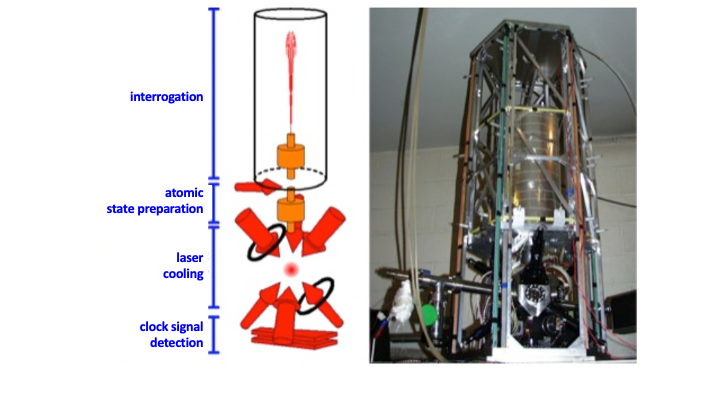COLD ATOM FOUNTAINS
The frequency stability of an atomic clock depends directly on the width of the resonance line which is proportional to the inverse of the interaction duration between the atoms and the oscillator radiation. The maximum Ramsey cavity length in a thermal beam clock is on the order of one meter in the largest devices and it does not seem realistic to try to gain an order of magnitude with this technique.
Laser-based cooling and manipulation of neutral atoms, developed in the 1980s, have led to a real revolution in the atomic clock world since these techniques ultimately make it possible to have a set of atoms with temperatures in the microkelvin range. Such low temperatures correspond to velocities of around a centimeter per second, several magnitude orders lower than those of thermal beams. The inventors of these techniques, Steven Chu, William Phillips and the French physicist Claude Cohen-Tannoudji were awarded the Nobel Prize in Physics in 1997.
The preferred cold atom clock configuration, called “cold atom fountain” seeks to take advantage of the gravity action on the low velocities of the cold atoms to optimize the interaction duration while achieving a double Ramsey interaction.

A set containing a few hundred million cold atoms (temperature: 1 µK) is obtained by interaction with three pairs of orthogonal stationary laser waves. After cooling, the atoms are launched upwards by slightly changing the cooling laser beams frequencies. After the launch, the atoms are prepared in the same quantum state, then all the laser beams are switched off to avoid any light displacement phenomenon during the interaction with the oscillator signal. This interaction takes place in a cylindrical microwave resonant cavity in two stages: a first interaction when the atoms cross the cavity in the upward direction and a second interaction when the atoms cross the same cavity in the downward direction. The clock signal, i.e., the atoms transition probability, is then detected by a laser-induced fluorescence technique. Thanks to gravity which refolds the atomic trajectories, it is possible to carry out a Ramsey interaction in a single cylindrical cavity, which leads to resonance line widths of the order of 1 Hz, the duration between the two interactions being 0.5 seconds. Moreover, the speed direction change between ascent and descent allows to strongly reduce the displacements related to the Doppler effect.
Operating principle of a laser-cooled atom fountain
There are about twenty cold atom fountains in operation in the world today. The best frequency stabilities obtained to date are 2. 10-14 t-1/2 (t: integration time). Note that this stability record level could only be achieved with the use of a cryogenic gallery mode oscillator to overcome the degradation due to the insufficient spectral purity of the interrogation laser (Dick effect). The best cold atom fountains accuracy operating with cesium or rubidium atoms, is in the 10-16 range.

After more than two decades of research and development, cold atom fountains have reached their maximum performance level, i.e., accuracy at the 10-16 level and long-term frequency stability in the 10-17 range. They are currently running in a more operational way in the framework of various applications: fundamental physics tests and in particular search for fundamental constants drift, International Atomic Time (TAI) calibration, long-term stability improvement of timescales, etc. Thanks to their performance and reliability, the fountains of the SYRTE alone contribute to about 40% of the International Atomic Time calibration.
